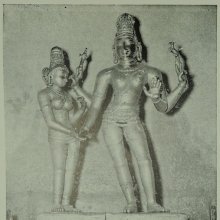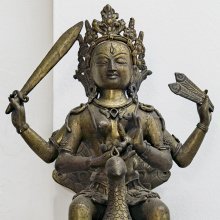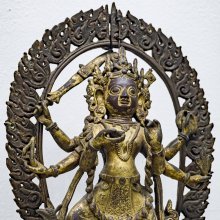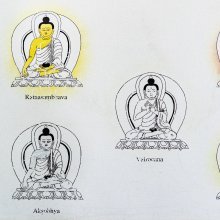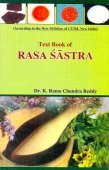Mayura, Mayūra, Māyūra: 39 definitions
Introduction:
Mayura means something in Buddhism, Pali, Hinduism, Sanskrit, Jainism, Prakrit, the history of ancient India, Marathi, Hindi, biology. If you want to know the exact meaning, history, etymology or English translation of this term then check out the descriptions on this page. Add your comment or reference to a book if you want to contribute to this summary article.
Images (photo gallery)
In Hinduism
Natyashastra (theatrics and dramaturgy)
Source: archive.org: The mirror of gesture (abhinaya-darpana)One of the Twenty-eight Single Hands (hasta):—Mayura (peacock): the third finger of the Kartarī-mukha hand is joined to the thumb, the other fingers extended. Usage: the peacock’s beak, a creeper, bird of omen (śakuna), vomiting,forehead, stroking the hair, forehead, brow-spot, wiping away tears, argument according to law (śāstra), renown.
Source: Shodhganga: Elements of Art and Architecture in the Trtiyakhanda of the Visnudharmottarapurana (natya)Mayura (मयुर) or Mayuragati refers to the “gait of the peacock” and represents one of the various Gatis (“way of walking”) (in Indian Dramas), according to the Abhinayadarpaṇa.—Accordingly, gaits (gatis) are explained along with some particular hand gestures. It shows that footsteps are to be followed by some hand postures. The gait of mayura i.e., peacock steps can be made by standing on toes and moving both the knees alternately. In this gait the actor or dancer should hold kapitthahasta with both hands.

Natyashastra (नाट्यशास्त्र, nāṭyaśāstra) refers to both the ancient Indian tradition (shastra) of performing arts, (natya—theatrics, drama, dance, music), as well as the name of a Sanskrit work dealing with these subjects. It also teaches the rules for composing Dramatic plays (nataka), construction and performance of Theater, and Poetic works (kavya).
Ayurveda (science of life)
Dietetics and Culinary Art (such as household cooking)
Source: Shodhganga: Dietetics and culinary art in ancient and medieval IndiaMayūra (मयूर) refers to the “peacock” as described in the 17th century Bhojanakutūhala (dravyaguṇāguṇa-kathana), and is commonly found in literature dealing with the topics of dietetics and culinary art, also known as Pākaśāstra or Pākakalā.—Mayūra is mentioned in a discusses regarding the reaction of certain insects and other living beings on consumption of poisionous food. The after-effect of intake of poison for Mayūra (peacock) is defined as: “hṛṣyet (delights at the sight of poison and this will reduce the valour of poison)”.
Veterinary Medicine (The study and treatment of Animals)
Source: archive.org: The Elephant Lore of the HindusMayūra (मयूर) refers to a “peacock” (resembling one of the sounds made by certain auspicious elephants), according to the 15th century Mātaṅgalīlā composed by Nīlakaṇṭha in 263 Sanskrit verses, dealing with elephantology in ancient India, focusing on the science of management and treatment of elephants.—[Cf. chapter 2, “on favorable marks”]: “16. The sounds like those of a haṃsa, crane, peacock (mayūra), koil, tiger, lion, and bull are rated high; inauspicious are those like a camel, crow, jackal, boar, and ape”.
Source: Shodhganga: Portrayal of Animal Kingdom (Tiryaks) in Epics An Analytical studyMayūra (मयूर) refers to the Peacock or Common Peafowl (Pavo Cristatus), according to scientific texts such as the Mṛgapakṣiśāstra (Mriga-pakshi-shastra) or “the ancient Indian science of animals and birds” by Hamsadeva, containing the varieties and descriptions of the animals and birds seen in the Sanskrit Epics such as the Ramayana and Mahabharata.
Toxicology (Study and Treatment of poison)
Source: Shodhganga: Kasyapa Samhita—Text on Visha ChikitsaMayūra (मयूर) is the name of an ingredient used in the treatment of Rājilā-snake-bites, according to the Kāśyapa Saṃhitā: an ancient Sanskrit text from the Pāñcarātra tradition dealing with both Tantra and Viṣacikitsā—an important topic from Āyurveda which deals with the study of Toxicology (Viṣavidyā or Sarpavidyā).—The tenth Adhyāya prescribes antidotes for Rājilā snake venom.—According to the Kāśyapasaṃhitā verse X.18: “Fumigation with the powder of the bark of dry ginger, Lodhra, Mayūra, Bilva, Nṛpadruma, Dvimukha, Śyāmikā and uraga destroy all poisons”.
Unclassified Ayurveda definitions
Source: archive.org: Sushruta samhita, Volume IMayūra (मयूर)—Sanskrit word for a bird, corresponding to “peacock”. This animal is from the group called Viṣkira (which scatter). Viṣkira itself is a sub-group of the group of animals known as Jāṅghala (living in high ground and in a jungle).
The flesh of the Mayura is astringent and saline in taste, and is beneficial to the skin, helps the growth of hair, improves the voice, intellect, appetite and relish for food, and imparts strength and vigour to the organs of sight and hearing.

Āyurveda (आयुर्वेद, ayurveda) is a branch of Indian science dealing with medicine, herbalism, taxology, anatomy, surgery, alchemy and related topics. Traditional practice of Āyurveda in ancient India dates back to at least the first millenium BC. Literature is commonly written in Sanskrit using various poetic metres.
Shilpashastra (iconography)
Source: Red Zambala: Hindu Icons and Symbols | Inner Circle IVMurugan’s vehicle is the Mayūra — peacock which represents pride, arrogance and notions of superiority which need to be controlled in order to cultivate skilful means.

Shilpashastra (शिल्पशास्त्र, śilpaśāstra) represents the ancient Indian science (shastra) of creative arts (shilpa) such as sculpture, iconography and painting. Closely related to Vastushastra (architecture), they often share the same literature.
Purana and Itihasa (epic history)
Source: archive.org: Puranic EncyclopediaMayūra (मयूर).—An asura who fought against Subrahmaṇya. Skanda Purāṇa, Vīramahendra Kāṇḍa describes the terrible battle between Mayūra and Subrahmaṇya. Mahābhārata, Ādi Parva, Chapter 65 says that after death, Mayūra was reborn in the world as a King named Viśva.
Source: archive.org: Shiva Purana - English Translation1) Mayūra (मयूर) refers to [peacock] birds that exhibit “various gestures of pleasing eagerness”, and were employed by Kāma (god of love) in an attempt to charm Śiva, according to the Śivapurāṇa 2.2.9. Accordingly as Kāma related to Brahmā:—“[...] Many pairs of deer and birds, playing about in front of the great lord Śiva, indeed exhibited many gestures of love to excite Him. Pairs of peacocks exhibited various gestures of pleasing eagerness with their gambolling tricks at His sides and in front of Him”.
Mayūra (“peacocks”) are delighted at the sound of the cloud over the Mandara mountain, according to the Śivapurāṇa 2.2.22. “[...] the peacocks are delighted at the sound of the cloud over the Mandara mountain. Their gleeful cackles and out-stretched tails indicate the incessant pleasure of their heart. [...] See the wickedness perpetrated by the clouds on my body. They are pelting it with hailstones. But they cover and protect the peacocks (Mayūra) and Cātakas who are their followers”.
2) Mayūra (मयूर) or “peacock” refers to the vehicle of Kārttikeya (Śiva’s son), according to the Śivapurāṇa 2.5.21 (“Description of the Special War”).—Accordingly, as Sanatkumāra narrated to Vyāsa: “On seeing the leaders of the Gaṇas, Nandin, Gaṇeśa and Kārttikeya, the Dānavas rushed at them for a duel combat. Kālanemi clashed with Nandin; Śumbha fought Gaṇeśa and Niśumbha hesitatingly (śaṅkita) rushed at Kārttikeya. With five arrows Niśumbha hit the peacock of Kārttikeya [kārtikeyasya mayūraṃ] in the chest and it fell unconscious. Then the infuriated Kārttikeya discharged five arrows at his chariot and pierced the horses and the charioteer. [...]”.
Source: Cologne Digital Sanskrit Dictionaries: The Purana Index1a) Mayūra (मयूर).—The riding animal of Kārttikeya; several on the Himālayas;1 a banner of Skanda presented to Vāyu.2
- 1) Brahmāṇḍa-purāṇa II. 25. 16, 27; III. 10. 47. Matsya-purāṇa 160. 21. Vāyu-purāṇa 36. 2; 54. 19.
- 2) Ib. 72. 46.
1b) A peak on the Varāha hill.*
- * Vāyu-purāṇa 42. 70.
Mayūra (मयूर) is a name mentioned in the Mahābhārata (cf. I.61.33) and represents one of the many proper names used for people and places. Note: The Mahābhārata (mentioning Mayūra) is a Sanskrit epic poem consisting of 100,000 ślokas (metrical verses) and is over 2000 years old.

The Purana (पुराण, purāṇas) refers to Sanskrit literature preserving ancient India’s vast cultural history, including historical legends, religious ceremonies, various arts and sciences. The eighteen mahapuranas total over 400,000 shlokas (metrical couplets) and date to at least several centuries BCE.
Dharmashastra (religious law)
Source: Prācyā: Animals and animal products as reflected in Smṛti textsMayūra (मयूर) or Śikhi refers to the bird “Peacock” (Pavo cristatus).—Birds have been described in several ancient Sanskrit texts that they have been treated elaborately by eminent scholars. These birds [viz., Mayūra] are enumerated in almost several Smṛtis in context of specifying the expiations for killing them and their flesh being used as a dietary article to give satisfaction to the manes (Pitṛs) in Śrāddha rites. These are elaborated especially in the Manusmṛti, Parāśarasmṛti [chapter VI], Gautamasmṛti [chapter 23], Śātātapasmṛti [II.54-56], Uśānasmṛti [IX.10-IX.12], Yājñavalkyasmṛti [I.172-I.175], Viṣṇusmṛti [51.28-51.29], Uttarāṅgirasasmṛti [X.16].

Dharmashastra (धर्मशास्त्र, dharmaśāstra) contains the instructions (shastra) regarding religious conduct of livelihood (dharma), ceremonies, jurisprudence (study of law) and more. It is categorized as smriti, an important and authoritative selection of books dealing with the Hindu lifestyle.
Shaktism (Shakta philosophy)
Source: Google Books: ManthanabhairavatantramMayūra (मयूर) refers to a “peacock”, according to the Śrīmatottara-tantra, an expansion of the Kubjikāmatatantra: the earliest popular and most authoritative Tantra of the Kubjikā cult.—Accordingly, “(Mālinī) is endless, supreme, subtle, omnipresent and both supreme (transcendent) and inferior (immanent). The supreme energy (kalā), she is the goddess who is consciousness present in the End of the Twelve. She is the subtle energy (kalā) and, very subtle, she flows forth as the supreme (life-giving) nectar. Her form is (wonderfully diverse) like a peacock’s tail [i.e., mayūra-candrikā-ākārā] and she resides in the Adamantine Wheel (vajracakra). [...]”.

Shakta (शाक्त, śākta) or Shaktism (śāktism) represents a tradition of Hinduism where the Goddess (Devi) is revered and worshipped. Shakta literature includes a range of scriptures, including various Agamas and Tantras, although its roots may be traced back to the Vedas.
Pancaratra (worship of Nārāyaṇa)
Source: archive.org: Catalogue of Pancaratra Agama TextsMayūra (मयूर) refers to one of the eight Āsanas (“yogic postures”) discussed in chapter 1 (Yogapāda) of the Padmasaṃhitā: the most widely followed of Saṃhitā covering the entire range of concerns of Pāñcarātra doctrine and practice (i.e., the four-fold formulation of subject matter—jñāna, yoga, kriyā and caryā) consisting of roughly 9000 verses.—Description of the chapter [āsanabheda-lakṣaṇa]:—Brahmā asks to know about Yogas. Bhagavān replies that there are two kinds of Yoga—karmayoga and jñānayoga. [...] A devotee may achieve liberation by either method [...] however, in the case of karmayoga it is to be noted that the eight steps are especially defined—Āsana, the third step, requires perfection of the eight positions [e.g., mayūra-āsana].

Pancaratra (पाञ्चरात्र, pāñcarātra) represents a tradition of Hinduism where Narayana is revered and worshipped. Closeley related to Vaishnavism, the Pancaratra literature includes various Agamas and tantras incorporating many Vaishnava philosophies.
In Buddhism
Theravada (major branch of Buddhism)
Source: Pali Kanon: Pali Proper NamesOne of the three palaces of Vidhurapandita. J.vi.289.
Theravāda is a major branch of Buddhism having the the Pali canon (tipitaka) as their canonical literature, which includes the vinaya-pitaka (monastic rules), the sutta-pitaka (Buddhist sermons) and the abhidhamma-pitaka (philosophy and psychology).
Tibetan Buddhism (Vajrayana or tantric Buddhism)
Source: Brill: Śaivism and the Tantric Traditions (tantric Buddhism)Mayūra (मयूर) refers to a “peacock”, according to the Bhūśalyasūtrapātananimittavidhi section of Jagaddarpaṇa’s Ācāryakriyāsamuccaya, a text within Tantric Buddhism dealing with construction manual for monasteries etc.—Accordingly, “[...] Songs of a jīvaṃjīvaka bird, peacock (mayūra), kokila bird, parrot, cakrāṅka, haṃsa, and a bull bring auspiciousness. If [these creatures] are seen, it brings prosperity. [...]”.

Tibetan Buddhism includes schools such as Nyingma, Kadampa, Kagyu and Gelug. Their primary canon of literature is divided in two broad categories: The Kangyur, which consists of Buddha’s words, and the Tengyur, which includes commentaries from various sources. Esotericism and tantra techniques (vajrayāna) are collected indepently.
In Jainism
General definition (in Jainism)
Source: archive.org: Een Kritische Studie Van Svayambhūdeva’s PaümacariuMayūra (मयूर) participated in the war between Rāma and Rāvaṇa, on the side of the latter, as mentioned in Svayambhūdeva’s Paumacariu (Padmacarita, Paumacariya or Rāmāyaṇapurāṇa) chapter 57ff. Svayambhū or Svayambhūdeva (8th or 9th century) was a Jain householder who probably lived in Karnataka. His work recounts the popular Rāma story as known from the older work Rāmāyaṇa (written by Vālmīki). Various chapters [mentioning Mayūra] are dedicated to the humongous battle whose armies (known as akṣauhiṇīs) consisted of millions of soldiers, horses and elephants, etc.

Jainism is an Indian religion of Dharma whose doctrine revolves around harmlessness (ahimsa) towards every living being. The two major branches (Digambara and Svetambara) of Jainism stimulate self-control (or, shramana, ‘self-reliance’) and spiritual development through a path of peace for the soul to progess to the ultimate goal.
India history and geography
Source: archive.org: Personal and geographical names in the Gupta inscriptionsMayura is another name for Māyāpura: a place name ending in pura mentioned in the Gupta inscriptions. Māyāpura is transformed into Mayura in the way that pura is changed to ur.
Source: Cologne Digital Sanskrit Dictionaries: Indian Epigraphical GlossaryMayūra.—(CII 1), a peacock; a bird in general. Note: mayūra is defined in the “Indian epigraphical glossary” as it can be found on ancient inscriptions commonly written in Sanskrit, Prakrit or Dravidian languages.

The history of India traces the identification of countries, villages, towns and other regions of India, as well as mythology, zoology, royal dynasties, rulers, tribes, local festivities and traditions and regional languages. Ancient India enjoyed religious freedom and encourages the path of Dharma, a concept common to Buddhism, Hinduism, and Jainism.
Biology (plants and animals)
Source: Wisdom Library: Local Names of Plants and DrugsMayura [ಮಯೂರ] in the Kannada language is the name of a plant identified with Achyranthes aspera L. from the Amaranthaceae (Amaranth) family. For the possible medicinal usage of mayura, you can check this page for potential sources and references, although be aware that any some or none of the side-effects may not be mentioned here, wether they be harmful or beneficial to health.
Source: Google Books: CRC World Dictionary (Regional names)1) Mayura in India is the name of a plant defined with Achyranthes aspera in various botanical sources. This page contains potential references in Ayurveda, modern medicine, and other folk traditions or local practices It has the synonym Centrostachys indica Standl. (among others).
2) Mayura is also identified with Apium graveolens It has the synonym Sison ruta Burm.f. (etc.).
Example references for further research on medicinal uses or toxicity (see latin names for full list):
· African Health Sciences (2006)
· Journal of the College of Science, Imperial University of Tokyo (1911)
· Economic Botany (1981)
· Journal of the Washington Academy of Sciences (1915)
· Numer. List (6924)
· Encyclopédie Méthodique, Botanique (Lamarck) (1783)
If you are looking for specific details regarding Mayura, for example extract dosage, health benefits, diet and recipes, chemical composition, side effects, pregnancy safety, have a look at these references.

This sections includes definitions from the five kingdoms of living things: Animals, Plants, Fungi, Protists and Monera. It will include both the official binomial nomenclature (scientific names usually in Latin) as well as regional spellings and variants.
Languages of India and abroad
Pali-English dictionary
Source: BuddhaSasana: Concise Pali-English Dictionarymayūra : (m.) peacock.
Source: Sutta: The Pali Text Society's Pali-English DictionaryMayūra, (Vedic mayūra) a peacock D. III, 201; S. II, 279; Th. 1, 1113; J. II, 144, 150 (°gīva)=DhA. I, 144; J. IV, 211 (°nacca); V, 304; VI, 172, 272, 483; Vv 111, 358 (=sikhaṇḍin VvA. 163); VvA. 27 (°gīva-vaṇṇa); Sdhp. 92. ‹-› The form mayūra occurs nearly always in the Gāthās and is the older form of the two m. and mora. The latter contracted form is found in Prose only and is often used to explain the old form, e, g. at VvA. 57. See also mora. (Page 524)

Pali is the language of the Tipiṭaka, which is the sacred canon of Theravāda Buddhism and contains much of the Buddha’s speech. Closeley related to Sanskrit, both languages are used interchangeably between religions.
Marathi-English dictionary
Source: DDSA: The Molesworth Marathi and English Dictionarymayūra (मयूर).—m (S) A peacock. 2 A flower, Cock's comb.
Source: DDSA: The Aryabhusan school dictionary, Marathi-Englishmayūra (मयूर).—m A peacock. A flower, cockscomb.
Marathi is an Indo-European language having over 70 million native speakers people in (predominantly) Maharashtra India. Marathi, like many other Indo-Aryan languages, evolved from early forms of Prakrit, which itself is a subset of Sanskrit, one of the most ancient languages of the world.
Sanskrit dictionary
Source: DDSA: The practical Sanskrit-English dictionaryMayūra (मयूर).—[mī ūran Uṇ 1.67]
1) A peacock; स्मरति गिरिमयूर एष देव्याः (smarati girimayūra eṣa devyāḥ) Uttararāmacarita 3.2; फणी मयूरस्य तले निषीदति (phaṇī mayūrasya tale niṣīdati) Ṛs. 1.13.
2) A kind of flower.
3) Name of a poet (author of the sūryaśataka); यस्याश्चोरश्चिकुरनिकरः कर्णपूरो मयूरः (yasyāścoraścikuranikaraḥ karṇapūro mayūraḥ) P. R.1. 22.
4) A kind of instrument for measuring time.
5) (In music) A kind of gait.
-rī A pea-hen; (Proverb :- varaṃ tatkālopanatā tittirī na punardivasāntaritā mayūrī Vb.1., or varamadya kapoto na śvo mayūraḥ 'a bird in the hand is worth two in the bush').
-ram A particular posture in sitting.
Derivable forms: mayūraḥ (मयूरः).
--- OR ---
Māyūra (मायूर).—a. (-rī f.) [मयूर-अण् (mayūra-aṇ)]
1) Belonging to or arising from a peacock; मायूरी मदयति मार्जना मनांसि (māyūrī madayati mārjanā manāṃsi) M.1. 21; Rām.2.91.7.
2) Made of the feathers of a peacock.
3) Drawn by a peacock (as a car).
4) Dear to a peacock.
-ram A flock of peacocks.
-rī Name of a plant (ajamodā).
Source: Cologne Digital Sanskrit Dictionaries: Shabda-Sagara Sanskrit-English DictionaryMayūra (मयूर).—m.
(-raḥ) 1. A peacock. 2. A flower, the coxcomb, (Celosia cristata.) 3. A plant, (Achyranthes aspera.) f. (-rī) 1. A pea-hen. 2. A potherb, (Basella rubra, &c.) E. mi to scatter, Unadi aff. ūran; or mahī the earth in the seventh case, mahyāṃ, ru to cry, ḍa aff. and the formation irr.
--- OR ---
Māyūra (मायूर).—mfn.
(-raḥ-rī-raṃ) Belonging to a peacock, made of its feathers, &c. n.
(-raṃ) A flock of peacocks. E. mayūra a peacock, and aṇ aff. of multitude, &c.
Source: Cologne Digital Sanskrit Dictionaries: Benfey Sanskrit-English DictionaryMayūra (मयूर).—I. m. 1. A peacock, [Hitopadeśa] i. [distich] 178, M. M. 2. The name of a flower and of a plant. Ii. f. rī, A peaben, [Uttara Rāmacarita, 2. ed. Calc., 1862.] 55, 8.
--- OR ---
Māyūra (मायूर).—i. e. mayūra + a, I. adj., f. rī. 1. Belonging to, or coming from, peacocks, [Rāmāyaṇa] 2, 100, 63 Gorr.; agreeable to peacocks, [Mālavikāgnimitra, (ed. Tullberg.)] [distich] 20. 2. Made of its feathers. Ii. n. A flock of peacocks.
Source: Cologne Digital Sanskrit Dictionaries: Cappeller Sanskrit-English DictionaryMayūra (मयूर).—[masculine] ī [feminine] peacock or hen; [abstract] tā† [feminine], tva† [neuter]
--- OR ---
Māyūra (मायूर).—[feminine] ī a peacock’[substantive]
Source: Cologne Digital Sanskrit Dictionaries: Aufrecht Catalogus Catalogorum1) Mayūra (मयूर) as mentioned in Aufrecht’s Catalogus Catalogorum:—father of Śaṅkuka. Śp. p. 90.
2) Mayūra (मयूर):—Padacandrikā lex.
Source: Cologne Digital Sanskrit Dictionaries: Monier-Williams Sanskrit-English Dictionary1) Mayūra (मयूर):—m. ([probably] [from] √2. mā) a peacock, [Vājasaneyi-saṃhitā; Lāṭyāyana; Mahābhārata] etc.
2) a cock, [cf. Lexicographers, esp. such as amarasiṃha, halāyudha, hemacandra, etc.]
3) a species of plant, [Suśruta] (Celosia Cristata or Achyranthes Aspera, [cf. Lexicographers, esp. such as amarasiṃha, halāyudha, hemacandra, etc.])
4) a kind of instrument for measuring time, [Sūryasiddhānta]
5) a kind of gait, [Saṃgīta-sārasaṃgraha]
6) Name of an Asura, [Mahābhārata]
7) of a poet, [Prasannarāghava]
8) (also with bhaṭṭa), of various other writers, [Catalogue(s)]
9) of the father of Śaṅkuka, [ib.]
10) of a mountain, [Mārkaṇḍeya-purāṇa]
11) n. a [particular] posture in sitting, [Catalogue(s)]
12) Name of a town, [Buddhist literature]
13) Māyūra (मायूर):—mf(ī)n. ([from] mayūra) belonging to or coming from a peacock, [Mahābhārata; Rāmāyaṇa] etc.
14) made of p°' feathers, [Varāha-mihira’s Bṛhat-saṃhitā]
15) drawn by p°, [Harivaṃśa]
16) dear to p°, [Mālavikāgnimitra]
Source: Cologne Digital Sanskrit Dictionaries: Yates Sanskrit-English Dictionary1) Mayūra (मयूर):—(raḥ) 1. m. A peacock; coxcomb flower. f. Peahen; potherb.
2) Māyūra (मायूर):—(raṃ) 1. m. A flock of peacocks. a. Belonging to a peacock.
Source: DDSA: Paia-sadda-mahannavo; a comprehensive Prakrit Hindi dictionary (S)Mayūra (मयूर) in the Sanskrit language is related to the Prakrit words: Maūra, Maūrā.
[Sanskrit to German]
Sanskrit, also spelled संस्कृतम् (saṃskṛtam), is an ancient language of India commonly seen as the grandmother of the Indo-European language family (even English!). Closely allied with Prakrit and Pali, Sanskrit is more exhaustive in both grammar and terms and has the most extensive collection of literature in the world, greatly surpassing its sister-languages Greek and Latin.
Hindi dictionary
Source: DDSA: A practical Hindi-English dictionaryMayūra (मयूर) [Also spelled mayur]:—(nm) a peacock; hence [mayūrī] (nf); -[nṛtya] a peacock-dance.
...
Kannada-English dictionary
Source: Alar: Kannada-English corpusMayūra (ಮಯೂರ):—
1) [noun] the large bird Pavo cristatus of Phasianidae family, with a tuft on the head, with blue feathers, male of which has long, attractive tail (each feather having an eye-like spot), while the female has a relaively short tail, domesicated as an ornamental bird; Indian peafowl or peacock.
2) [noun] the plant Celosia cristata of Amaranthaceae family; cock’s comb.
3) [noun] the small plant Achyranthes aspera of Amaranthaceae family, used as an astringent depurative, as a remedy in dropsy and as an antidote to the venom of scorpion.
4) [noun] the plant Artemisia maritima of Asteraceae family.
5) [noun] its seed; worm seed.
6) [noun] (pros.) a metrical verse having four lines of three groups of three syllables each (uuu, uu-, u—).
--- OR ---
Māyūra (ಮಾಯೂರ):—
1) [adjective] of or relating to a peacock.
2) [adjective] made of peacock feathers.
--- OR ---
Māyūra (ಮಾಯೂರ):—[noun] a multitude of peacocks.
Kannada is a Dravidian language (as opposed to the Indo-European language family) mainly spoken in the southwestern region of India.
Nepali dictionary
Source: unoes: Nepali-English DictionaryMayūra (मयूर):—n. a peacock;
Nepali is the primary language of the Nepalese people counting almost 20 million native speakers. The country of Nepal is situated in the Himalaya mountain range to the north of India.
See also (Relevant definitions)
Partial matches: Maya.
Starts with (+25): Mayura bhatta, Mayura panta, Mayura-parivena, Mayuracataka, Mayurachuda, Mayuracitra, Mayuracitraka, Mayuracuda, Mayuragati, Mayuraghrita, Mayuragriva, Mayuragrivaka, Mayurahasta, Mayurahastaka, Mayurajangha, Mayurakalpa, Mayurakamtha, Mayurakarna, Mayuraketu, Mayurakhandi.
Query error!
Full-text (+281): Mattamayura, Mayurashikha, Mayurari, Mayuracataka, Mayuracuda, Tilamayura, Mayurapadaka, Mayuratuttha, Mayuraghrita, Mayurapiccha, Kridamayura, Mayuragati, Mayuram, Mayuravyamsaka, Mayuracitraka, Mayuragrivaka, Mayuraketu, Mahamayura, Mayurakarna, Mayurasana.
Relevant text
Search found 100 books and stories containing Mayura, Maya-uira, Maya-uīra, Mayūra, Māyūra, Mayūrā; (plurals include: Mayuras, uiras, uīras, Mayūras, Māyūras, Mayūrās). You can also click to the full overview containing English textual excerpts. Below are direct links for the most relevant articles:
Kavyamimamsa of Rajasekhara (Study) (by Debabrata Barai)
Part 7.7 - Poetic conventions regarding to the Birds < [Chapter 5 - Analyasis and Interpretations of the Kāvyamīmāṃsā]
Part 7.15 - Poetic conventions regarding to the Identity of Twelve Suns < [Chapter 5 - Analyasis and Interpretations of the Kāvyamīmāṃsā]
Animal Kingdom (Tiryak) in Epics (by Saranya P.S)
Chapter 4.31 - The Mayura (Peacock) in the Epics
Chapter 4.20 - Animals and birds in the epic Ramayana (Introduction)
Chapter 4.1 - Animals and Birds in the Epics and their classifications
Later Chola Temples (by S. R. Balasubrahmanyam)
Temples in Mayuram < [Chapter XII - Temples of Kulottunga III’s Time]
Temples in Mayuram < [Chapter XIV - Temples of Rajaraja III’s Time]
Temples in Tirumananjeri < [Chapter XII - Temples of Kulottunga III’s Time]
Vasudevavijaya of Vasudeva (Study) (by Sajitha. A)
Vedāṅga (six auxiliary disciplines) < [Chapter 5 - Impact of other Disciplines in Vāsudevavijaya]
Garga Samhita (English) (by Danavir Goswami)
Verses 2.17.15-17 < [Chapter 17 - The Meeting of Śrī Rādhā-Kṛṣṇa]
Verse 1.18.9 < [Chapter 18 - Vision of the Universal Form]
Verse 2.4.17 < [Chapter 4 - The Liberation of Vatsāsura]
Amarakoshodghatana of Kshirasvamin (study) (by A. Yamuna Devi)
Fauna (12): Synonyms added by Kṣīrasvāmin < [Chapter 5 - Aspects of Nature]
Music (Nāṭya-varga) < [Chapter 4 - Cultural Aspects]
Related products
